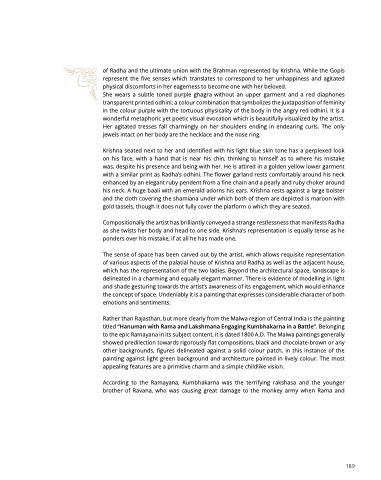Page 195 - Eye of the beholder
P. 195
of Radha and the ultimate union with the Brahman represented by Krishna. While the Gopis represent the five senses which translates to correspond to her unhappiness and agitated physical discomforts in her eagerness to become one with her beloved.
She wears a subtle toned purple ghagra without an upper garment and a red diaphones transparent printed odhini; a colour combination that symbolizes the juxtaposition of feminity in the colour purple with the tortuous physicality of the body in the angry red odhini. It is a wonderful metaphoric yet poetic visual evocation which is beautifully visualized by the artist. Her agitated tresses fall charmingly on her shoulders ending in endearing curls. The only jewels intact on her body are the necklace and the nose ring.
Krishna seated next to her and identified with his light blue skin tone has a perplexed look on his face, with a hand that is near his chin, thinking to himself as to where his mistake was, despite his presence and being with her. He is attired in a golden yellow lower garment with a similar print as Radha’s odhini. The flower garland rests comfortably around his neck enhanced by an elegant ruby pendent from a fine chain and a pearly and ruby choker around his neck. A huge baali with an emerald adorns his ears. Krishna rests against a large bolster and the cloth covering the shamiana under which both of them are depicted is maroon with gold tassels, though it does not fully cover the platform o which they are seated.
Compositionally the artist has brilliantly conveyed a strange restlessness that manifests Radha as she twists her body and head to one side. Krishna’s representation is equally tense as he ponders over his mistake, if at all he has made one.
The sense of space has been carved out by the artist, which allows requisite representation of various aspects of the palatial house of Krishna and Radha as well as the adjacent house, which has the representation of the two ladies. Beyond the architectural space, landscape is delineated in a charming and equally elegant manner. There is evidence of modelling in light and shade gesturing towards the artist’s awareness of its engagement, which would enhance the concept of space. Undeniably it is a painting that expresses considerable character of both emotions and sentiments.
Rather than Rajasthan, but more clearly from the Malwa region of Central India is the painting titled “Hanuman with Rama and Lakshmana Engaging Kumbhakarna in a Battle”. Belonging to the epic Ramayana in its subject content, it is dated 1800 A.D. The Malwa paintings generally showed predilection towards rigorously flat compositions, black and chocolate-brown or any other backgrounds, figures delineated against a solid colour patch, in this instance of the painting against light green background and architecture painted in lively colour. The most appealing features are a primitive charm and a simple childlike vision.
According to the Ramayana, Kumbhakarna was the terrifying rakshasa and the younger brother of Ravana, who was causing great damage to the monkey army when Rama and
189


